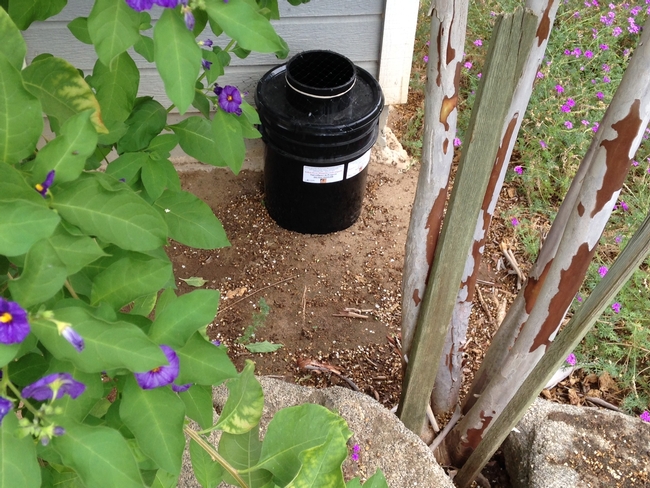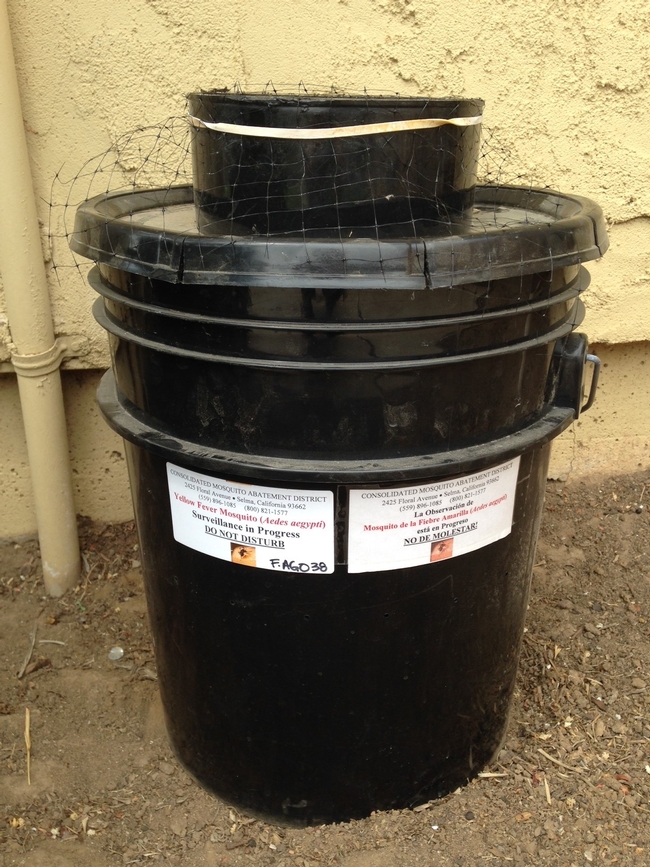
Not all mosquitos are alike. Certain mosquitos have the ability to spread certain viruses. The illnesses spread by Ae. aegypti – yellow fever, dengue fever and more recently Chikungunya – were never given much thought in California, until now.
To test a new weapon in the arsenal against Ae. aegypti, Cornel is working with Consolidated Mosquito Abatement District personnel to deploy 146 mosquito death traps in the front yards of homes in a neighborhood east of Clovis Elementary School in Clovis. The traps were supplied by the Centers for Disease Control and made by hand in Puerto Rico.
The traps look like black five-gallon buckets. Orchard grass and water are placed inside.
“When the orchard grass decomposes, it releases a plume of chemicals that attracts female Ae. aegypti to lay their eggs in,” Cornel said.
A screen prevents them from flying down to the water to lay eggs, but the mosquitos adhere to black sticky paper that lines the top opening of the trap. Each week, district officials will count the number of mosquitos that have been trapped inside. Meanwhile, other, more sophisticated traps will continue to monitor Ae. aegypti mosquitos in the test area and in two other nearby neighborhoods where Ae. aegypti have been found.

The most deadly disease spread by Ae. aegypti is yellow fever. The illness has claimed hundreds of thousands of lives over centuries, mainly in tropical countries of Central and South America and Africa. A safe and effective vaccine is available, but yellow fever still takes a toll where medical infrastructure is inadequate.
Ae. aegypti also spreads dengue fever, for which there is no vaccine. Also known as “breakbone fever,” increasing cases of dengue worldwide is attributed to urban adaptations of this mosquito, human population growth, increased international travel and global warming.
A less severe but still debilitating disease, Chikungunya, is caused by a virus that mutated in 2005 in a way that allows it to switch vectors and be transmitted by Ae. aegypti and another mosquito Aedes albopictus. Chikungunya, which means “to be contorted” in an East African tribal language, causes a fever at first and later joint pain that can persist for months. However, more than half the people who contract Chikungunya have no symptoms at all. In July, two Florida residents were the first Americans who hadn't traveled outside the country to contract Chikungunya.
The arrival of Chikungunya in the United States has given greater urgency to officials trying to eradicate Ae. aegypti in California. Mosquito abatement officials have been going door-to-door, and with homeowners' permission, walking properties to make sure any pools of standing water are drained and treated with a pesticide that will kill mosquito larva if the receptacle again collects water. Treatment of landscape foliage with pyrethroid is also used for mosquito control, however, preliminary research by Cornel has found that Ae. aegypti possess a mutation that potentially allows them to resist chemical exposure, which requires further research to confirm their resistance status.
The map below shows the study area. The new mosquito death traps were placed in the front yards of homes in area "A."